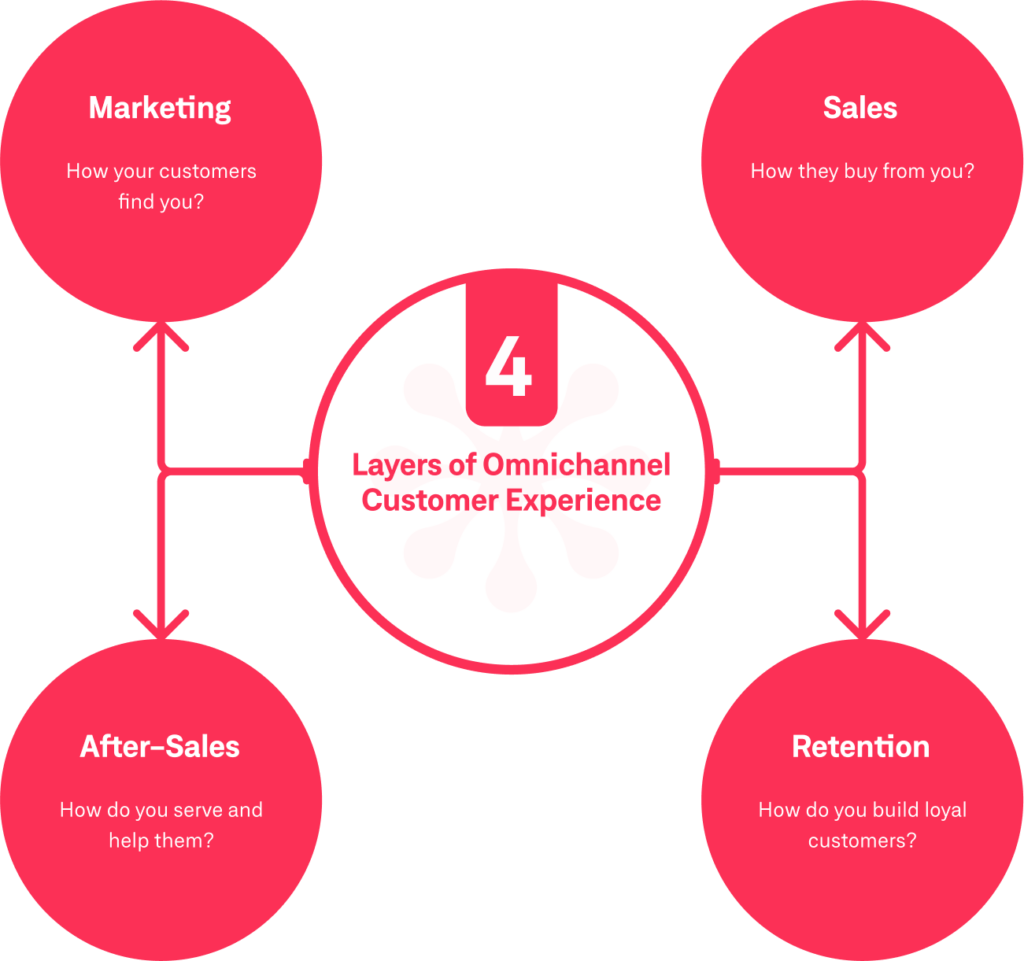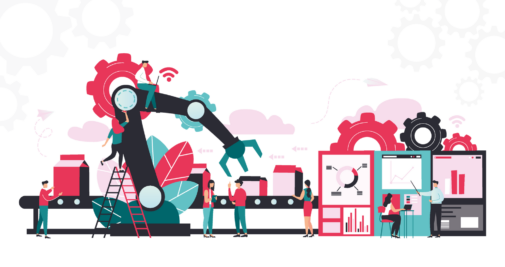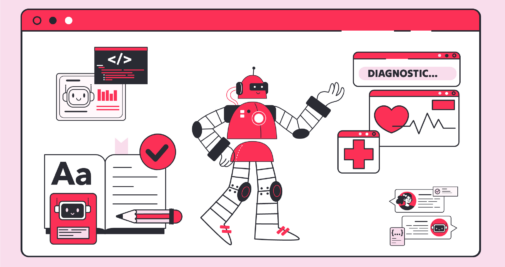This website uses cookies so that we can provide you with the best user experience possible. Cookie information is stored in your browser and performs functions such as recognising you when you return to our website and helping our team to understand which sections of the website you find most interesting and useful.
There is a fine line that separates multichannel and omnichannel customer experience.
Indeed, both concepts entail there is more than one touchpoint where people can interact with your business. However, they don’t both imply all moving parts of the business are breathing as one, aligned, fluid whole.

First, let’s start by illuminating one important distinction.
Multi or Omnichannel: What’s The Difference?
Say – for the sake of understanding – there are two companies: Company A and Company B. Both are hybrid commerces, meaning, the buying process takes place on more than one channel. In this case, it’s through e-commerce and good old brick-and-mortar.
Company A’s plan is to reach more customers. The math is simple – more stores and avenues, more sales. And, truth be told, the plan won’t only ramp up sales but should also help diversify the risk. When one channel flops (like retail during Covid), another one ensures the revenue still heaps up. However, Company A doesn’t bother spending too many resources trying to connect the dots. Each store and e-shopping space acts as a single interaction instance. Management’s reasoning? – As long as “it spikes the revenue curve” it doesn’t need fixing.
On the other hand, Company B goes far and above to understand the customer journey – from start to finish. Having many channels isn’t just an instinctual decision. It’s means of providing customers with well-needed attention all across their journey. To do so, they need to make sure all dots exist, of course – but are also linked and tuned together to provide answers to important business questions.
Both Company A and Company B accomplished their goals. However, one of the two actually got the most out of the situation. Their customer’s purchase frequency got a lot higher. Their customers spent more money, online and offline alike. Most importantly, a large portion of their customers reported their affection for a company due to the seamless communication experience along their journey.
Can you guess which one it was: Company A or Company B?
What is Omnichannel Customer Experience?

By embracing an omnichannel strategy, businesses can move away from a one-dimensional approach to customer relationships.
Rather than having a ‘just sell and do so through multiple touchpoints‘ business setup, this method offers a more comprehensive approach that starts by truly serving and building trust with the customer. And as much as 46% of customers say they’d pay more to businesses they trust.
The omnichannel strategy essentially means your business is interacting with customers over different channels throughout their journeys in a cohesive and seamless way.
Bottom line, you use a variety of channels to give your customers exactly what they need when they need it – doesn’t matter if it’s selling, marketing, or providing customer support.
4 Layers of Omnichannel Customer Experience
Working on an omnichannel customer experience isn’t just about boosting sales; it’s about leveraging a holistic approach to provide customers with top-notch service…
Sure, marketers need to create compelling ads, sales reps need to close deals, and design needs to boost user experience – but delivering an A+ customer experience means taking the initiative to ensure satisfaction and synchronicity across different layers. These four in particular:
- Marketing
- Sales
- After-sales support
- Customer Retention

With the right foundation in place, businesses can serve their customers better – before, during and after the sale. Being aware of these four knobs should encourage repeat business and lasting relationships.
#1 Marketing – How they get to know you
Marketing is a vital element of the omnichannel customer experience. It’s the first layer your customers go through when they first see and meet your brand. It’s how you make an impression and later – through all four levels – make sure you maintain it.
Although common sense, customer experience marketing is one of those things so many companies know of but put off. Maybe because it’s “just marketing stuff” or maybe it’s because providing value goes beyond ads and actually demands a serious effort. However, the benefits easily outweigh the pains. From more sales and better feedback to higher customer loyalty and brand recognition.
With all that in mind, here’s how you actually turn “just marketing” into customer-oriented care:
- Use the tried-and-true media: Connect with your audience through the channels they prefer and respond timely
- Communicate genuinely: Your customers are pretty good in recognizing bs, especially in a long run. Make sure you are always true to your words.
- Overdeliver: Train your personnel and put systems in place that help you offer the best possible experience to your customers.
- Collect and process customer data: This is how you get to know your audience and provide different departments with valuable customer insights.
#2 Sales – How they buy from you
Sales don’t equal transactions. It actually boils down to a buying experience and the customer’s perception of your business throughout. Why?
Buyers make a choice – or transactions if you will – based on experience. When you focus on improving that experience, you consider all the different elements that affect sales, not just transactions. What you’re left with at the end is: a) ironically, more transactions and b) a frictionless buying experience.
Now, the million-dollar question: what do your customers expect when buying? Well, again, there’s more that goes into it. Let’s put ourselves in customers’ shoes for a second and see their main expectations:
- My needs and questions are understood and addressed
- Company’s responses are relevant, timely, and useful
- The company acts in my best interest, not theirs
Now, whether your performance metrics plummet, stagnate, or go through the roof depends on how well you meet those expectations. Having all systems in place, like business intelligence and customer relationship management, will ensure higher profits.
#3 After-sales – How you serve your buyers
After-purchase or after-sales service includes any support or assurance given to the customer upon completed transaction.
The reason it’s crucial lies in the fact that 96% of customers never return if the company fails to provide decent after-sales service. On top of that – according to Salesforce – as much as 89% of consumers are more likely to make another purchase after a positive customer service experience.
Not only can satisfied customers bolster word-of-mouth, they also have a higher customer lifetime value. This indicates that making clients happy post-sales can lead to a higher ROI, as it opens up referral programs and repeat sales.
Never mind the general impression, customer support is not the only pillar of after-sales service. Here are the most time-tested parts that make up a full-scope post-purchase service:
- Product or service demos: Making sure customer onboarding goes as smooth as possible. Plus, you need your users to fully understand the full potential of your product or service.
- Omnichannel support: For hybrid commerce, it’s important your customers can reach your support staff or automation through various channels. Web, chatbots, info and call centers, social media, and even 1-on-1 calls.
- Warranty: Not only regular warranty services but product replacements and money-back guarantees. Be warned though… if your personnel still has to manually search customer information to validate warranties, you’ll be head-high in logistics. Btw go here if you think your business is stuck in tiresome processes.
#4 Loyalty – How you keep them yours
Repeat customers are a gold mine of sustained profitability. About half of a company’s revenue, on average, is from approximately 8% of their most loyal consumers. Plus, it costs way less to keep a customer than to find a new one.
Utilizing your existing customer base depends on your ability to deliver on all of the three elements above. To choose you over the competition long-term, your customers will expect marketing integrity, a frictionless sales process, and superb customer service.
Besides that, here’s what else you could do to get your customers to rave about your company:
- Discounts and rewards: Exclusive offers, free gifts for higher spend, segmented discounts based on customer avatar profiles, etc.
- Point systems: Loyalty systems based on purchase history, reward points, loyalty tiers, cross-channel discount cards and codes.
- Collect reviews and feedback: Most millennials and z-shoppers read reviews before buying. To build loyalty, consider responding to your customer’s opinions.
- Have Loyalty Management CRM: Collect and store relevant customer data within a single place. Use the data to personalize customer’s experiences.
Let Technology Support Your Omnichannel Strategy
As companies face the challenge of delivering a better experience, many don’t know where to start or may default to implementing changes that are biased toward their own experience instead of their customers’. This is where business intelligence (BI) in customer experience comes into play.
With BI tools, companies can leverage software and services to collect raw data, and then convert it into actionable insights. Instead of relying on business fortune-tellers or guesswork, businesses can make well-informed decisions that are tailored to their customer’s needs. Therefore, harnessing the power of BI in customer experience should be a top priority for any company looking to implement a successful omnichannel customer experience strategy.



